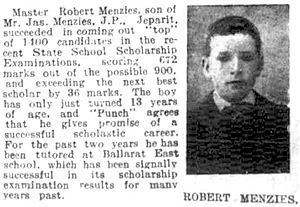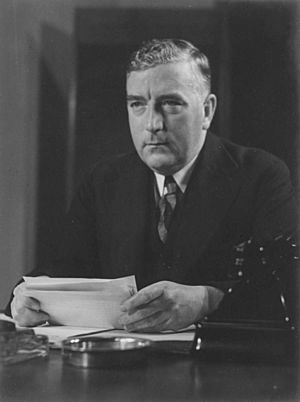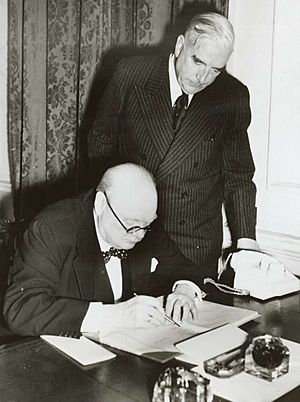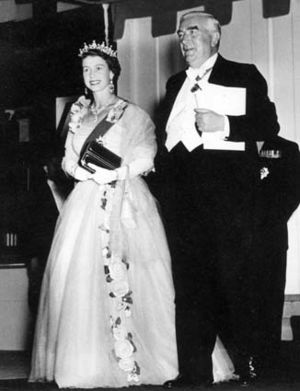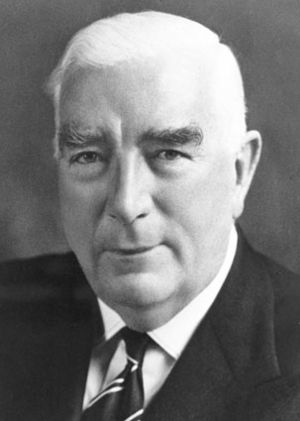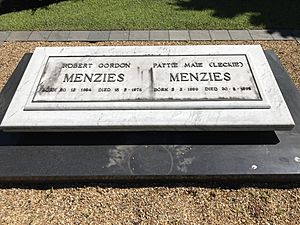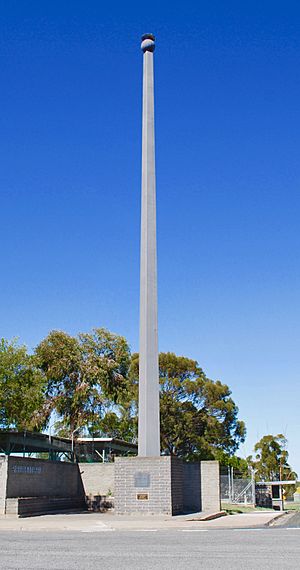Robert Menzies facts for kids
Quick facts for kids
Robert Menzies
|
|||||||||||||||||||||||||||||||||||||||||
|---|---|---|---|---|---|---|---|---|---|---|---|---|---|---|---|---|---|---|---|---|---|---|---|---|---|---|---|---|---|---|---|---|---|---|---|---|---|---|---|---|---|

Menzies in the 1950s
|
|||||||||||||||||||||||||||||||||||||||||
| 12th Prime Minister of Australia | |||||||||||||||||||||||||||||||||||||||||
| In office 19 December 1949 – 26 January 1966 |
|||||||||||||||||||||||||||||||||||||||||
| Monarch | |||||||||||||||||||||||||||||||||||||||||
| Governor-General | |||||||||||||||||||||||||||||||||||||||||
| Deputy | |||||||||||||||||||||||||||||||||||||||||
| Preceded by | Ben Chifley | ||||||||||||||||||||||||||||||||||||||||
| Succeeded by | Harold Holt | ||||||||||||||||||||||||||||||||||||||||
| In office 26 April 1939 – 29 August 1941 |
|||||||||||||||||||||||||||||||||||||||||
| Monarch | George VI | ||||||||||||||||||||||||||||||||||||||||
| Governor-General | Lord Gowrie | ||||||||||||||||||||||||||||||||||||||||
| Deputy |
|
||||||||||||||||||||||||||||||||||||||||
| Preceded by | Earle Page | ||||||||||||||||||||||||||||||||||||||||
| Succeeded by | Arthur Fadden | ||||||||||||||||||||||||||||||||||||||||
| Leader of the Opposition | |||||||||||||||||||||||||||||||||||||||||
| In office 23 September 1943 – 19 December 1949 |
|||||||||||||||||||||||||||||||||||||||||
| Prime Minister | |||||||||||||||||||||||||||||||||||||||||
| Deputy | Arthur Fadden | ||||||||||||||||||||||||||||||||||||||||
| Preceded by | Arthur Fadden | ||||||||||||||||||||||||||||||||||||||||
| Succeeded by | Ben Chifley | ||||||||||||||||||||||||||||||||||||||||
|
|||||||||||||||||||||||||||||||||||||||||
|
|||||||||||||||||||||||||||||||||||||||||
|
|||||||||||||||||||||||||||||||||||||||||
| Personal details | |||||||||||||||||||||||||||||||||||||||||
| Born |
Robert Gordon Menzies
20 December 1894 Jeparit, Colony of Victoria |
||||||||||||||||||||||||||||||||||||||||
| Died | 15 May 1978 (aged 83) Malvern, Victoria, Australia |
||||||||||||||||||||||||||||||||||||||||
| Resting place | Melbourne General Cemetery | ||||||||||||||||||||||||||||||||||||||||
| Political party | Liberal | ||||||||||||||||||||||||||||||||||||||||
| Other political affiliations |
|
||||||||||||||||||||||||||||||||||||||||
| Spouse |
Pattie Leckie
(m. 1920) |
||||||||||||||||||||||||||||||||||||||||
| Children | 4 | ||||||||||||||||||||||||||||||||||||||||
| Parents |
|
||||||||||||||||||||||||||||||||||||||||
| Relatives |
|
||||||||||||||||||||||||||||||||||||||||
| Education |
|
||||||||||||||||||||||||||||||||||||||||
| Alma mater | Wesley College, University of Melbourne | ||||||||||||||||||||||||||||||||||||||||
| Profession |
|
||||||||||||||||||||||||||||||||||||||||
Sir Robert Gordon Menzies (born 20 December 1894 – died 15 May 1978) was a very important Australian politician. He was the 12th Prime Minister of Australia and held the job for more than 18 years. This makes him the longest-serving Prime Minister in Australia's history. He was Prime Minister from 1939 to 1941 and again from 1949 to 1966.
Menzies played a key role in starting the Liberal Party of Australia. He helped shape its ideas and how it reached out to people. He studied law at the University of Melbourne and became a top lawyer in Melbourne. Before becoming Prime Minister, he was the Deputy Premier of Victoria from 1932 to 1934. Then he moved to the Federal Parliament.
In April 1939, after Prime Minister Joseph Lyons died, Menzies became the leader of the United Australia Party (UAP) and then Prime Minister. He led Australia into World War II in September 1939. After losing support from his party, he resigned in August 1941. He then helped create the new Liberal Party and became its first leader in 1945.
In the 1949 election, Menzies led the Liberal-Country coalition to victory and became Prime Minister again. His focus on family values and a growing economy helped him win. He won seven elections in a row during his second time as Prime Minister. He retired in January 1966. His government is remembered for developing Canberra, expanding immigration, focusing on higher education, and its national security policies. Australia sent troops to the Korean War, the Malayan Emergency, and the Vietnam War during his time.
Contents
- Robert Menzies: Early Life and Education
- Robert Menzies: Becoming a Political Leader
- Robert Menzies: First Time as Prime Minister
- Robert Menzies: Building the Liberal Party
- Robert Menzies: Second Time as Prime Minister
- Robert Menzies: Later Life and Legacy
- Robert Menzies: Published Works
- Robert Menzies: Awards and Honours
- Robert Menzies: Ministries
- Robert Menzies: Portrayals in Film and TV
- Robert Menzies: Eponyms
- Images for kids
- See also
Robert Menzies: Early Life and Education
Birth and Family Background
Robert Gordon Menzies was born on 20 December 1894 in Jeparit, Victoria. He was the fourth of five children of Kate and James Menzies. Robert was the first Australian Prime Minister whose parents were both born in Australia. His father was from Ballarat, and his mother was from Creswick.
His grandparents came to Australia because of the Victorian gold rush. Robert was proud of his Scottish background. He preferred his last name to be said the Scottish way, "MING-iss," which led to his nickname "Ming."
Childhood Years
Robert grew up in a small country town. He started school in 1899 at Jeparit State School, which was a one-room school. When he was about eleven, he moved to Ballarat to live with his grandmother.
In 1907, at 13, he came first in the state-wide scholarship exams. This helped pay for his high school education at private schools. He went to Grenville College in Ballarat and then Wesley College in Melbourne. He was not good at sports but was excellent in his studies.
University Studies
In 1913, Menzies started studying law at the Melbourne Law School. He won many awards and scholarships. He graduated with a Bachelor of Laws in 1916 and a Master of Laws in 1918.
He was very good at debating and was known as a bright student. During World War I, Menzies served in a part-time military unit. Unlike many others, he did not volunteer to serve overseas. This decision was later used against him by his political rivals. His family decided it was best for him to continue his studies.
Robert Menzies: Becoming a Political Leader
Starting in State Politics
After finishing university, Menzies became a lawyer. He focused on constitutional law. In 1920, he worked on an important case that changed how power was shared between the Australian government and the states. This case helped him become well-known. He was made a King's Counsel in 1929, which is a special title for a senior lawyer.
In 1928, Menzies entered state parliament in Victoria. He represented the Nationalist Party of Australia. He believed in democracy, the rule of law, and free enterprise. He became a minister and then Deputy Premier of Victoria from 1932 to 1934.
Moving to Federal Politics
In 1934, Menzies left state parliament to join federal politics. He won the seat of Kooyong for the United Australia Party (UAP). He was immediately made Attorney-General of Australia and Minister for Industry.
Before World War II, Menzies had discussions about Germany. He supported the idea of trying to avoid war, known as "appeasement." He also spoke out against the unfair treatment of Jewish people in Nazi Germany. However, by September 1939, he realized that war was unavoidable. He believed that if Adolf Hitler's expansion was not stopped, there would be no peace in the world.
Robert Menzies: First Time as Prime Minister
Leading Australia into World War II
When Prime Minister Joseph Lyons died in April 1939, Menzies was elected leader of the UAP and became Prime Minister. A challenge arose when Earle Page, another leader, refused to work with him. Menzies formed a government, and later, the Country Party joined his government.
When Germany invaded Poland, Britain and France declared war on 3 September 1939. Menzies immediately announced that Australia was also at war. He spoke to the nation on the radio, saying it was his "melancholy duty" to inform them.
Menzies was worried about the threat from Japan. Australia had small forces and relied on Britain for defense. He tried to unite the country, but it was difficult because he had not served in the war himself. In the 1940 election, his party lost some seats, and he had to form a minority government with the help of two independent members.
War Strategy and Challenges
Menzies sent Australian troops to help Britain in the Middle East and Singapore. He also asked Winston Churchill, the British Prime Minister, to strengthen naval forces in the Far East. Menzies was concerned about the safety of the Singapore naval base.
In 1941, Menzies spent four months in Britain discussing war plans with Churchill. His position back home became weaker. The failure of the Allied mission to Greece, where Australian troops fought, also damaged his reputation.
Resignation as Prime Minister
Menzies's party and the opposition party were tied in parliament. He needed the Labor Party's support to travel to Britain for war discussions, but they refused. With his support gone, Menzies resigned as Prime Minister on 27 August 1941.
Arthur Fadden became the new Prime Minister, but his government only lasted 40 days. Menzies was disappointed and almost left politics. He remained in parliament, and in 1943, he was re-elected as the leader of the UAP.
Robert Menzies: Building the Liberal Party
The Forgotten People
After losing the prime ministership, Menzies spent time talking to ordinary Australians. He called them "the Forgotten People." He gave weekly radio talks, and a collection of these talks was published as a book called The Forgotten People.
In these talks, Menzies shared his ideas about politics. He talked about individual freedom, responsibility, the rule of law, and the importance of the middle class. These ideas became the foundation for a new political party.
Forming the Liberal Party
Menzies realized that the UAP needed to change. In 1944, he brought together different anti-Labor parties. They decided to merge and form one new party: the Liberal Party of Australia. The Liberal Party was officially launched in August 1945, with Menzies as its leader.
The new Liberal-Country Coalition faced its first election in 1946 but lost to the Labor Party. However, over the next few years, people's opinions started to change.
The 1949 Election Victory
The Cold War began, and fears about communism grew. In 1947, the Labor government tried to take over private banks, which many middle-class Australians did not like. Menzies used this to gain support. He also led a successful campaign against a government proposal to extend wartime powers.
In the 1949 election, Menzies promised to fight communism and support free enterprise. He also pledged to control inflation and end petrol rationing. His Liberal-Country Coalition won the election, and Menzies became Prime Minister again on 19 December 1949. This victory showed that his ideas about anti-communism and free enterprise were popular in Australia after the war.
Robert Menzies: Second Time as Prime Minister
Cold War and National Security
The new government was very focused on the threat of communism. Menzies tried to ban the Communist Party in 1950, but the High Court said it was against the law. He then held a public vote (referendum) in 1951 to change the Constitution to allow a ban, but it was narrowly defeated.
Menzies sent Australian troops to the Korean War. Before the 1954 election, he announced that a Soviet diplomat had left Russia and shared evidence of a spy ring in Australia. This event, known as the Petrov Affair, helped Menzies win the election. After this, the Labor Party split, and Menzies's government won the next two elections easily.
Australia's Place in the World
During Menzies's time, the world changed a lot. European countries, including Britain, were leaving their colonies. Menzies kept strong ties with Australia's traditional friends like Britain and the United States. He also focused on building relationships with countries in Asia.
In 1951, Australia, New Zealand, and the United States signed the ANZUS treaty, a security agreement. Menzies said this pact was based on "good will" and "unqualified friendship." His government also started the Colombo Plan, which allowed thousands of students from Asian countries to study in Australia. He also made trade agreements with Japan, Malaya, and Indonesia.
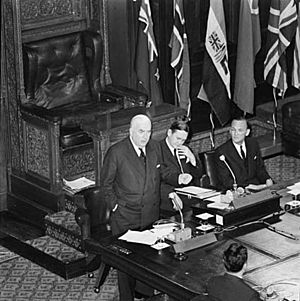
Economic and Social Changes
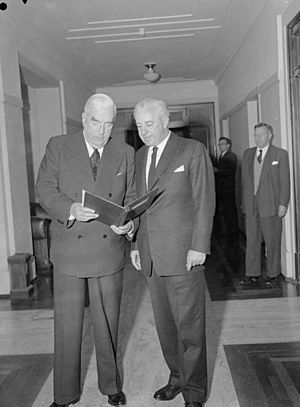
Menzies believed in free enterprise and self-reliance. His government focused on encouraging businesses, boosting exports, and building public works like power and water systems.
His government also brought in social reforms. In 1962, all Aboriginal people gained the right to vote in federal elections. In 1960, a new plan was introduced to help pay for medicines. Other help included money for aged care homes, increased pensions, and unemployment benefits. In 1961, a new law made divorce laws the same across Australia.
In 1962, Menzies's government started providing money to independent and Catholic schools for science facilities and scholarships. In 1965, married women were allowed to become permanent public servants, ending old discrimination.
Immigration and Education
Menzies's government continued and expanded Australia's immigration program. From 1949, non-European refugees and Japanese war brides were allowed to stay or enter Australia. The "dictation test," which was used to stop certain migrants, was removed in 1958. This made it easier for people from different backgrounds to come to Australia.
The government also greatly increased funding for higher education. They introduced scholarships to help students from all backgrounds go to university. This led to a big growth in university life in Australia.
Developing Canberra
Menzies's government played a big part in developing Canberra as Australia's capital city. They created a special commission in 1957 to plan and oversee Canberra's growth. During his time, many government departments moved from state capitals to Canberra.
Robert Menzies: Later Life and Legacy
Menzies retired as Prime Minister in January 1966, at the age of 71. He was the last Australian Prime Minister to leave office on his own terms. He was replaced by Harold Holt, his former Treasurer. Menzies left parliament in February 1966, after 32 years.
After retiring, he became the head of the University of Melbourne from 1967 to 1972. Many universities around the world gave him honorary degrees for his work in education. In 1965, he was given the special role of Lord Warden of the Cinque Ports in England.
In 1971, Menzies had a severe stroke, which left him partly paralyzed. He had another stroke in 1972. In 1977, he received a special award, a knighthood of the Order of Australia, from Queen Elizabeth II.
Personal Life
On 27 September 1920, Menzies married Pattie Leckie. They had three children: Kenneth, Ian, and Heather. Their home in Kew, Melbourne, was their family home for 25 years.
Death and Funeral
Robert Menzies died from a heart attack on 15 May 1978, at his home in Malvern, Melbourne. Tributes came from all over the world, including from Queen Elizabeth II and the Prime Minister of Australia, Malcolm Fraser.
He was given a state funeral in Melbourne, which was one of the largest ever held in Australia. Over 100,000 people lined the streets. His ashes, along with his wife's, are buried in the 'Prime Ministers Garden' at Melbourne General Cemetery.
Menzies's Impact
Menzies was the longest-serving Prime Minister of Australia, holding office for over 18 years. He rebuilt the conservative side of Australian politics after a difficult period. During his time, Australia became a richer country, and people had more leisure time.
Many stories are told about Menzies. Once, when someone shouted that they wouldn't vote for him even if he were an angel, Menzies famously replied, "If I were the Archangel Gabriel, I'm afraid you wouldn't be in my constituency."
Many books have been written about Robert Menzies. The National Museum of Australia has a collection of items related to him, including his medals and awards. His personal library of almost 4,000 books is kept at the University of Melbourne Library.
Robert Menzies: Published Works
- To the people of Britain at war from the Prime Minister of Australia. Speeches delivered in Great Britain in 1941. (1941)
- The Forgotten People and Other Studies in Democracy (1942)
- Speech is of Time: Selected Speeches and Writings (1958)
- Afternoon Light: Some Memories of Men and Events (1967)
- Central Power in the Australian Commonwealth (1967)
- The Measure of the Years (1970)
- Dark and Hurrying Days: Menzies's 1941 Diary (1993)
- Letters to My Daughter (2011)
Robert Menzies: Awards and Honours
- In 1950, he received the Legion of Merit (Chief Commander) from the US President.
- In 1951, he was appointed to the Order of the Companions of Honour (CH).
- Many universities, including the University of Sydney and Cambridge, gave him honorary Doctor of Laws degrees.
- In 1954, a portrait of Menzies by Sir Ivor Hele won the Archibald Prize.
- In 1963, Menzies was made a Knight of the Order of the Thistle (KT), an honour from Scotland. He is the only Australian to receive this.
- In 1973, he received Japan's Order of the Rising Sun, Grand Cordon, First Class.
- In 1976, he was appointed a Knight of the Order of Australia (AK).
- In 1984, an electoral division in Melbourne was named the Division of Menzies in his honour.
- The Menzies Research Centre was created in 1994.
- In 2009, the R.G. Menzies Walk was opened in Canberra. A statue of him was placed there in 2012.
- Several buildings and places are named after him, like the Menzies building at Monash University.
Decorations
 1950, he was appointed a Chief Commander of the Legion of Merit
1950, he was appointed a Chief Commander of the Legion of Merit 
 1951, he was appointed a Companion of the Order of the Companions of Honour (CH)
1951, he was appointed a Companion of the Order of the Companions of Honour (CH) 
 1963, he was appointed a Knight of the Order of the Thistle (KT)
1963, he was appointed a Knight of the Order of the Thistle (KT) 
 1973, he was appointed a Grand Cordon First Class of the Order of the Rising Sun
1973, he was appointed a Grand Cordon First Class of the Order of the Rising Sun 
 1976, he was appointed a Knight of the Order of Australia (AK)
1976, he was appointed a Knight of the Order of Australia (AK) 
Medals
 1935, he was awarded the King George V Silver Jubilee Medal
1935, he was awarded the King George V Silver Jubilee Medal 
 1937, he was awarded the King George VI Coronation Medal
1937, he was awarded the King George VI Coronation Medal 
 1953, he was awarded the Queen Elizabeth II Coronation Medal
1953, he was awarded the Queen Elizabeth II Coronation Medal 
Freedom of the City
Menzies was given the "Freedom of the City" honour in several places:
Robert Menzies: Ministries

- First Menzies Ministry
- Second Menzies Ministry
- Third Menzies Ministry
- Fourth Menzies Ministry
- Fifth Menzies Ministry
- Sixth Menzies Ministry
- Seventh Menzies Ministry
- Eighth Menzies Ministry
- Ninth Menzies Ministry
- Tenth Menzies Ministry
Robert Menzies: Portrayals in Film and TV
- In the 1984 mini-series The Last Bastion, he was played by John Wood.
- In the 1987 mini-series Vietnam, he was played by Noel Ferrier.
- In the 1988 mini-series True Believers, he was played by John Bonney.
- In the 1996 Egyptian film Nasser 56, he was played by Hassan Kami.
- In the 2007 film Curtin, he was played by Bille Brown.
- In the 2008 TV documentary Menzies and Churchill at War, he was played by Matthew King.
- Max Gillies has played Menzies in comedy shows.
- In the 2015 documentary The Dalfram Dispute 1938, he was played by Bob Baines.
- In a 2016 episode of A Place to Call Home, he was played by Alan Dearth.
Robert Menzies: Eponyms
- Sir Robert Menzies Memorial Foundation
- Menzies School of Health Research Australia
- R. G. Menzies Building, Australian National University Library
- Menzies Research Centre
- Menzies College (La Trobe University)
- Robert Menzies College (Macquarie University)
- Sir Robert Menzies Building (Monash University, Clayton Campus)
- The Australian federal electoral division of Menzies.
- Menzies Wing (Wesley College, Melbourne)
- Menzies Research Institute
- Menzies Wing (St John's College, University of Sydney)
- Sir Robert Menzies Park, in Wahroonga, New South Wales
- Sir Robert Menzies Reserve, in Malvern, Victoria
Images for kids
See also
 In Spanish: Robert Menzies para niños
In Spanish: Robert Menzies para niños


